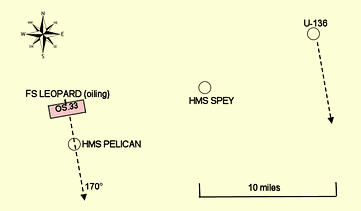|
|
On June 29, 1942, U-136 sailed from St. Nazaire
on her third patrol. She was sunk (see below) only three days after she
joined the wolf pack and only twelve days at sea, without inflicting any
damage on the convoy and was the only U-boat to be sunk during the course
of Convoy OS.33. During her short career, U-136 had sunk seven vessels
for a total of 25.499 tons.
At 1350 on the afternoon of July 11 , 1942, west of Madeira in position
33.30N, 22.52W, U-136 was steaming on the surface, 19 miles to the east
of the convoy and maintaining a parallel course when she was seen from
the crow's nest of HMS Spey about 9 miles away. HMS Spey immediately gave
chase at full speed while the U-boat turned away and attempted to escape
on the surface, emitting clouds of 'vapourish yellow smoke'. U-136 eventually
dived about 15 minutes after being observed some 14,000 yards from the
warship. When HMS Spey reached the point where the U-boat had submerged,
there was a thin film of oil and a large piece of clean kapok (a similar
but larger piece had been observed about a mile before the diving position).
The first attack with a 14 depth charge pattern was made by HMS Spey at
1525, a second one at 1534 and a third attack at 1554 followed by a 24
round hedgehog attack at 1603 (see HMS Spey's U-boat
report). After the second attack, a partially filled kapok life-belt,
with the stuffing protruding from the side and a piece of wood with a
hole at either end floated to the surface in the middle of the pattern.
It was assumed that, when observed, the crew had been filling life belts
on deck and that the high speed had washed some kapok off the deck and
left some on the surface when she submerged The life belt was assumed
to have been jammed on the upper deck or conning tower and shaken loose
by the second set of explosions. After the second attack, the U-boat's
speed was greatly reduced (2-3 kts) and she was almost stationary after
the third. HMS Spey was then joined by FS Léopard and HMS Pelican. FS
Léopard made two further runs of 10 depth charges each and observed some
'whitish foam' which was thought to be air bubbles. HMS Spey then followed
with a further hedgehog attack. At 1722, HMS Pelican attacked with a 10
charge pattern after which contact with the U-boat was lost by all three
vessels. It was assumed (correctly) that she had gone into vertical descent.
HMS Spey remained to sweep a 10 x 5 mile area without further contact
until 2200 but only traces of thin and widely dispersed oil were observed.
HMS Pelican reported this final position as 33.28N 23.28W.
While admitting the threat that this U-boat
posed to the convoy, it is hard not to have sympathy for the U-boat crew.
They experienced 6 separate depth charge attacks consuming 92 type VII
depth charges (and two ineffective hedgehog attacks with 48 charges) over
a period of three and a half hours before losing control and descending
irreversibly to the seabed, 2,400 fathoms (nearly two and a half miles)
below. There were no survivors from the U-boat crew of 45.
|
|
 U-136
U-136